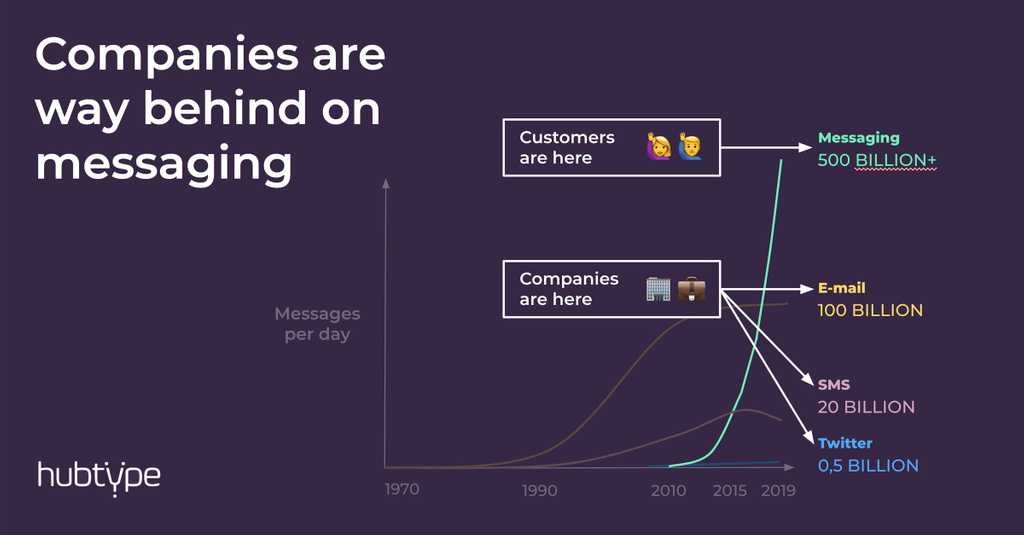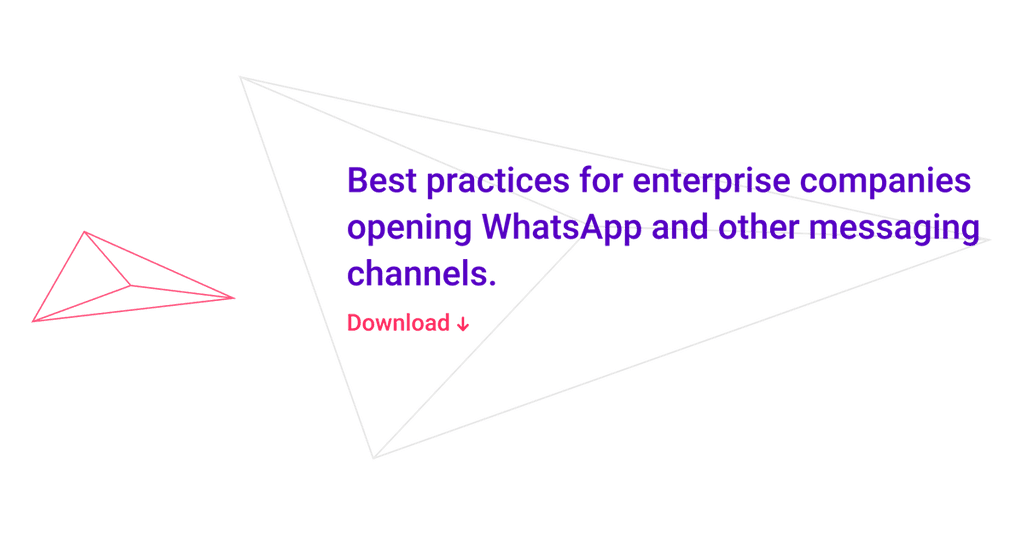Research reveals that even though 7 in 10 businesses think they are communicating effectively with customers – only 2 in 10 consumers agree. The reality is, businesses are way behind on customer communication preferences. Bridging the communication gap is essential for today’s businesses.
A messaging app, like WhatsApp, may well have been one of the first things you checked this morning. It will probably be one of the last things you use before you go to sleep tonight.
We spend more than 3 hours a day communicating on messaging apps: sharing photos, voice notes, documents and live locations. This shouldn’t come as a surprise to you, because you’re doing it too.
Companies are way behind customers on messaging
Your customers are trying to engage with you, but not in the way that many brands might like to think. 91% of your customers’ time on mobile and desktop devices is spent on messaging apps.
Messaging apps are a hub for social referrals and conversations that move the needle. For example, people share recommendations and links to ecommerce sites on these apps. Yet, companies are way behind customers on messaging. The result is a communication gap that leads to customer frustration and missed revenue opportunity.
The barriers to conversational messaging
Well more than half of us would rather message a brand than call customer service. Despite this, very few companies actually offer messaging as a communication channel.
According to an Oracle survey from 2016, 80% of businesses wanted chatbots by 2020. Why, then, do we still find ourselves waiting on hold for a painfully long time for something that we should be able to do with a quick message?
Customer service teams are already overwhelmed with existing email and phone channels. These channels are difficult to manage and have a high cost to serve. Email, in particular, takes longer than most channels to reach a resolution.
Combining automation and messaging
Businesses know that opening messaging channels is good for business. More efficient customer service means happier customers — which means more revenue. But, there is still a fear to add (yet another) means of contact for customers. They fear that they will add to the workload of their already drowning support teams.
Those who fear the issue of scale are missing one critical detail. With automation, they can handle a large volume of questions without the need for any humans. This is the missing piece that businesses need to embrace a conversational strategy.
At Hubtype, we know the power of automation. Especially when it’s used in combination with human agents and great conversational design. Our clients usually automate 80% of support tickets. In general, 80% of their support tickets come from predictable interactions.
So, rather than increasing workloads on customer support teams, messaging does the opposite. Messaging effectively reduces ticket volumes across channels.
The secret to bridging the communication gap is to combine automation and humans in a thoughtful way. The power and efficiency of automation complement the authenticity and service of humans.
The secret to scaling messaging channels is to combine automation and humans in a thoughtful way. The power and efficiency automation complement the authenticity and service of humans.
Moreover, brands use bots to get their customers queries solved in record time. Then, they provide great service to the remaining 20% with human agents. Besides pleasing your customers, your team isn’t inundated with as many repetitive questions. Instead, they’re able to focus on more interesting cases.
Which companies are bridging the communication gap?
Winning brands are already using conversational apps–and Hubtype is powering them. In fact, since we set out three years ago, we’ve powered conversational apps for Bankia, HP, Massimo Dutti, Volkswagen and many others. Here are just a few examples of how brands gain lifetime value and reduce friction with conversational apps:
- JPMorgan Chase, Bank of America, Marriott, and Coca-Cola report massive returns on their chatbot investments
- Marriott’s use of messaging apps has grown 85% month over month.
- Swedbank’s chatbot, Nina, handles 40,000 conversations a month and resolves 81% of the issues
- 1–800-Flowers reports that more than 70% of its Messenger orders are derived from new customers
- Globe Telecom increased customer satisfaction by 22% while decreasing call volume by 50%
These stories are not outliers. Once the channel is launched, customers tend to consolidate to a single channel, too. This eliminates duplicate queries across different channels.
Goodbye chatbots. Hello conversational apps.
When we talk about automation, we’re not just talking about chatbots. The companies truly excelling with conversational strategies use conversational apps.
Conversational apps combine texting with the UX of websites and apps. Interactions with customers include embedded elements that help keep things intuitive. What’s more, this happens without leaving the app.
These rich-media elements include:
- attachments
- carousels
- calendars
- time selectors
- buttons
Guided flows are incorporated into the UX design of conversational apps. This make it as easy as possible for a customer to complete a desired transaction or action. Moreover, conversational apps reduce the time it takes to complete a goal. Rich elements also increase the chances of a customer completing that goal.
Let’s say, for example, you’re booking a flight with a text-based chatbot. With a text-based interface, you’d need to type out each question and answer, as well as the date and time. This process is time-consuming, which leads to unhappy customers.
With a conversational app, a customer can click a button to “book a flight.” Then, they can choose an available date and time from an embedded calendar and time selector. This saves time, increases the number of conversions and improves the customer experience.
What’s stopping you from bridging the communication gap?
Conversational apps are the future. The communication gap we’ve described is only widening as more people move from the web to chat.
It’s time for companies to get out of the dinosaur age and embrace the significant benefits messaging will actually give them after their learning curve.
Bridging the communication gap doesn’t have to be difficult. Contact Hubtype today to talk about your conversational app strategy.


